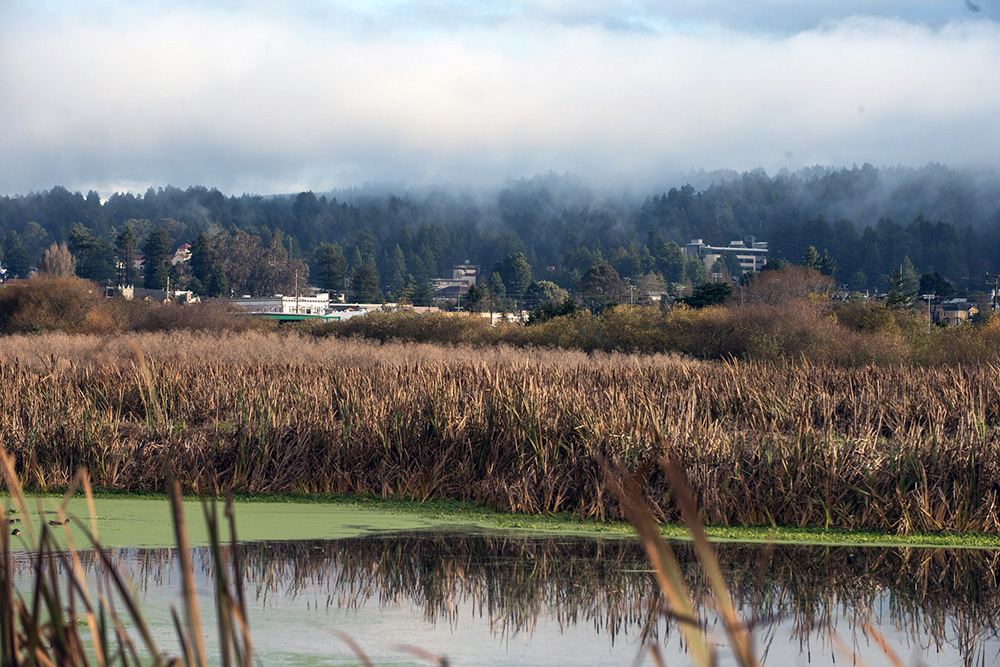For more than four decades, Robert Gearheart has been dedicated to understanding wetland systems and sharing his wisdom and passion with others. He’s reached hundreds of students over the years.
The professor emeritus of Environmental Resources Engineering (ERE) and his wife, Mary, have ensured that legacy of environmental education continues for future students: They have designated the Cal Poly Humboldt Foundation as the beneficiary of an Individual Retirement Account within their estate, valued at about $240,000. The generous gift will permanently endow the Gearheart Ecological Engineering Research Fund, which the Gearhearts established last year.
The fund supports research in nature-based technologies through paid graduate fellowships and undergraduate research assistantships. It also provides equipment and travel funding in support of faculty research. Faculty and students in ERE and any major in the College of Natural Resources & Sciences are eligible to apply for the fund.
Ensuring financial resources are open to several science majors reflects what Professor Gearheart sees is a strength of ERE.
“ERE requires a multidisciplinary approach. You need to learn biology and chemistry and other subjects to design and solve problems. All are part of coming up with solutions to complex environmental issues,” says Professor Gearheart, who started teaching at Humboldt in 1975.
Humboldt’s recent polytechnic designation inspired him to explore how best to support the ERE program, which is among the largest, oldest, and most respected ABET-accredited undergraduate environmental engineering programs in the country.
“Mary and I want to provide students the opportunity to experience Humboldt’s amazing program. We feel it’s crucial to support and advance the incredible teaching, learning, and research happening at Humboldt,” Professor Gearheart says.
Mary says the endowment also reinforces the pioneering spirit of the program. “ERE had enough foresight in the 1970s to see the need for engineering and the role it can play in the environment. I’ve been so impressed by the quality of the faculty who have come through this department and the work they do. I’m also impressed by the quality of its alumni.”
Fiona Connor is one of those alumni. After receiving her bachelor’s degree in ERE in 2021 Fiona entered Humboldt’s Environmental Systems graduate program and is the first recipient of the fellowship through the Gearheart’s fund. She says that, thanks to the Gearhearts, she was able to acquire the equipment and invaluable hands-on learning she needs to complete her master’s thesis on microplastics.
“Along with some supplies and DNA work, the fellowship funded the flight and fee to use the Moore Institute for Plastic Pollution lab in Long Beach to analyze my samples. I am humbled to be chosen for the fellowship, and I’m so grateful to the Gearhearts for their generosity. Bob is a phenomenal mentor and has fostered a truly unique experience for students.”
Professor Gearheart’s impact has been far reaching, spanning a 40 year career as an educator, researcher, and design engineer. He has mentored and inspired Cal Poly Humboldt students, including Fiona, through his teaching and research on the use of wetlands for wastewater treatment and pollution abatement. He brought a unique perspective and knowledge on the design of engineered natural treatment systems (specifically constructed wetlands) to the engineering program—infusing a multidisciplinary perspective that became a program strength and continues today.
Working with funding from the City of Arcata, he has been able to open doors to learning experiences unique to Cal Poly students. For example, as an ERE undergraduate, Fiona was hired by Professor Gearheart to work at the Arcata Marsh Research Institute, which he founded in 2007. Since then, students at the institute have helped collect, analyze, and maintain data on wetlands that are used to treat the City’s wastewater and enhance a wildlife sanctuary.
Professor Gearheart has also dedicated his life to understanding biogeochemical cycles of wetland systems and how those processes can help to transform waste to a resource. His ecologic engineering focus has led him to assist with projects in many countries in the development and support of natural systems for water and wastewater treatment. This effort has allowed him and his students to work with ecological engineered systems around the world.
He is also one of the founding designers of the groundbreaking Arcata Marsh and Wildlife Sanctuary that serves as a wastewater treatment plant, a recreation area, and a wildlife sanctuary.
Year after year, the marsh project serves as a living lab for undergraduate and graduate science students at Humboldt.
“You need to give students the opportunity to access the rich diversity of faculty expertise and students across disciplines. The problems of the world, such as climate change, will require a wide diversity of knowledge and different approaches to understand issues and solve problems,” Professor Gearheart says.
Photo: Robert Gearheart, professor emeritus of Environmental Resources Engineering, is a founding designer of the Arcata Marsh and Wildlife Sanctuary.

